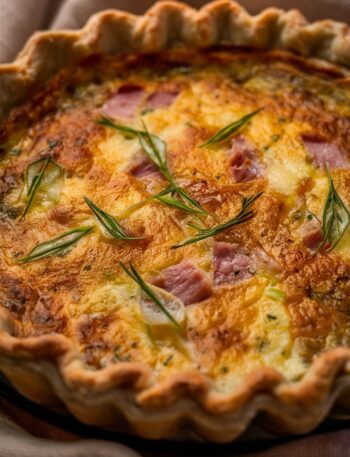Few dishes carry the weight of tradition, celebration, and family connection quite like Pizza Rustica, also known as Pizza Gaina. This rich, savory pie, layered with cured meats, creamy cheeses, and tender eggs, has graced Italian Easter tables for generations. To many Southern Italian families, it represents more than just food—it embodies the joy of abundance after Lent, a culinary symbol of togetherness, and a reminder of heritage passed down through time.
In this complete guide, you’ll learn not only how to prepare Pizza Rustica step by step but also the cultural stories behind it, expert baking tips, creative variations, serving ideas, and answers to the most common questions. By the end, you’ll have everything you need to master this iconic dish and share it with your loved ones.
The Story Behind Pizza Rustica
Pizza Rustica has its roots in Southern Italy, particularly in regions like Campania, Calabria, and Abruzzo. Traditionally, it was baked on Holy Saturday and served on Easter Sunday, marking the end of Lenten fasting.
During Lent, families refrained from rich foods like meats, eggs, and cheeses. Pizza Rustica was a way to bring those ingredients back to the table in one decadent dish. The pie was often made in large portions so it could be shared with extended family and guests, reflecting the Italian emphasis on hospitality and abundance.
Different households and towns adapted their own versions. Some pies were denser with meats, while others highlighted cheese and herbs. Over time, Italian immigrants carried this tradition across the globe, especially to the United States, where Pizza Rustica became a festive staple in Italian-American communities.
Why You’ll Love This Italian Easter Pie
Pizza Rustica isn’t just another pie—it’s an experience. Here’s why it has stood the test of time:
- Deeply Traditional: Every bite connects you with centuries of Italian culture.
- Savory & Filling: Packed with meats and cheeses, it’s hearty enough to serve as a full meal.
- Perfect for Celebrations: Especially suited for spring holidays and family gatherings.
- Make-Ahead Friendly: In fact, it tastes even better the next day after the flavors meld together.
- Rich & Comforting: The flaky crust and creamy filling are soul-satisfying.
Ingredient Highlights
To make an authentic Pizza Rustica, you’ll need both pastry dough for the crust and a generous filling of meats, cheeses, and eggs. Let’s break it down:
For the Dough
- Pie Dough: You can use homemade or high-quality store-bought dough. You’ll need enough for both a bottom and a top crust. Cold dough is best for a flaky finish.
For the Filling
- Ricotta Cheese: Creamy, slightly tangy, and the heart of the filling.
- Mozzarella, Provolone, Parmesan: A blend of melty, sharp, and salty flavors.
- Cured Meats: Common choices include soppressata, capicolla, Genoa salami, and ham. Choose 3–4 varieties for complexity.
- Italian Sausage: Adds a rich, savory depth.
- Eggs: Provide structure and bind the filling together.
- Black Pepper & Nutmeg: Essential seasonings for balance.
- Parsley (optional): Fresh herbiness for contrast.
Pro Tips Before You Start
- Drain Ricotta Well: Excess liquid can make the filling soggy. Place ricotta in a sieve or cheesecloth for an hour before use.
- Keep Dough Cold: Warm dough becomes tough and difficult to work with.
- Chop Ingredients Evenly: Uniform cubes of meat and cheese ensure even baking and a beautiful cross-section.
- Avoid Overbaking: If the crust browns too quickly, cover it loosely with foil.
- Rest Overnight: Flavors develop beautifully and slicing becomes much easier.
Step-by-Step: How to Make Pizza Rustica
Step 1: Prepare the Dough
Roll out one portion of dough and line a greased springform or deep-dish pan. Let the edges overhang slightly.
Step 2: Cook the Sausage
Brown the Italian sausage in a skillet until fully cooked. Drain the fat and allow it to cool.
Step 3: Make the Filling
In a large bowl, whisk together ricotta, eggs, parmesan, pepper, nutmeg, and parsley. Fold in cooled sausage, diced cured meats, and shredded cheeses.
Step 4: Assemble the Pie
Pour the filling into the prepared crust. Roll out the second portion of dough and cover the pie. Trim, fold, and crimp the edges. Cut slits or a small vent in the center to release steam. Brush with beaten egg for shine.
Step 5: Bake
Bake at 350°F (175°C) for 70–90 minutes, until the crust is golden and the filling is set. Tent with foil if the crust browns too quickly.
Step 6: Cool & Chill
Let the pie cool completely in the pan. For best results, refrigerate overnight before slicing.
What to Serve with Pizza Rustica
Pairing matters. Since Pizza Rustica is rich, it’s best served with light, fresh sides:
- Roasted Asparagus or Carrots: Bright, springtime vegetables balance the richness.
- Arugula Salad with Lemon Vinaigrette: Peppery greens add freshness.
- Antipasto Platter: Olives, marinated vegetables, and pickles complement the savory pie.
- Sparkling Wine or Citrus Spritzer: Refreshing drinks cut through the heaviness.
Variations & Substitutions
Pizza Rustica is versatile. Customize it to your taste or dietary needs:
- Hard-Boiled Eggs: A traditional addition for festive symbolism.
- Basket Cheese: A seasonal cheese often used in Italian Easter pies.
- Spinach or Chard: Adds color, nutrition, and freshness.
- Alternative Cheeses: Fontina or Swiss for different flavor profiles.
- Make It Spicy: Use hot soppressata or add crushed red pepper flakes.
- Vegetarian Version: Skip the meats and double up on vegetables and herbs.
Storage & Leftovers
- Refrigerate: Store in an airtight container for up to 5 days.
- Freeze: Wrap slices tightly in plastic and foil; freeze for up to 2 months.
- Reheat: Warm in a 325°F oven until heated through. For a crisp crust, reheat uncovered.
Frequently Asked Questions
Is Pizza Rustica the same as Pizzagaina?
Yes, they are two names for the same dish, though variations exist by region and family.
Can I make it ahead of time?
Absolutely. In fact, Pizza Rustica tastes even better the next day.
Can I add vegetables?
Yes—spinach, sautéed onions, or roasted peppers are great additions.
What’s the best pan to use?
A springform pan is ideal for easy release and neat slices.
Should it be served warm or cold?
Traditionally, it’s served at room temperature or chilled, but gently reheating works too.
Can I use store-bought dough?
Yes—choose a high-quality dough to save time without sacrificing taste.
Final Thoughts: Why Pizza Rustica Matters
Pizza Rustica is more than just an Easter recipe. It’s a celebration of resilience, family bonds, and culinary creativity. Preparing it is an act of love, a way to connect with past generations, and a tradition to pass forward.
Whether you’re carrying on family customs or discovering this dish for the first time, each slice tells a story. Make it once, and you’ll understand why Italian households treasure this pie every spring.
Bring it to your Easter table—or any special occasion—and watch how quickly it becomes part of your family’s traditions too.





